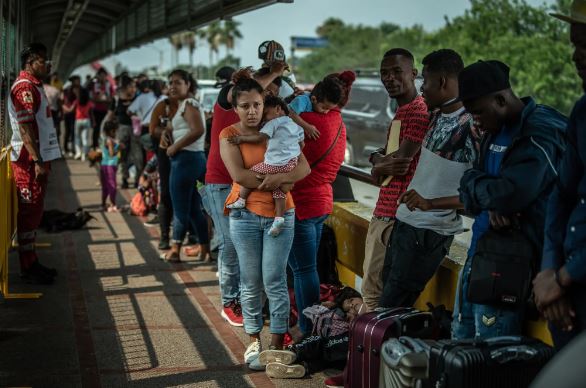The Biden administration on Thursday announced it will expand former President Donald Trump’s wall on the Mexican border and begin deporting thousands of Venezuelans in a bid to cut down on the migratory influx that shows no signs of abating.
The White House has changed its position in response to political pressure to slow the influx of newcomers. Criticism is increasing among Republicans as well as Democratic officials in New York, Chicago and elsewhere who claim the inflow is straining their abilities to house and feed the migrants.
During his candidature for president, Mr. Biden rejected proposals to build a wall along the U.S.-Mexico border, saying it was “not a serious policy solution.” The government said on Thursday that it will be bypassing more than 20 federal rules and regulations in order to build physical barriers in South Texas, close to McAllen.
The Biden administration reversed a policy of not returning migrants to the troubled South American country, where years of political unrest and economic turmoil have prompted millions of people to flee, when it announced that it would begin deporting Venezuelans who enter the United States unlawfully. In only one month, a record 50,000 people from that country crossed the southern border, making them the biggest nationality group in the United States behind Mexicans.
Only three weeks before to the deportation order, the government had granted temporary legal status to hundreds of thousands of illegally present Venezuelan migrants. This was done to alleviate some of the pressure on New York and Chicago, which have been struggling to accommodate the thousands of migrants, many of whom are from Venezuela, who are seeking employment.
The deportation decision on Thursday appeared to be the administration’s response to criticism that it had stoked more emigration from Venezuela by awarding Temporary Protected Status to so many of its citizens.
Secretary of Homeland Security Alejandro N. Mayorkas issued a statement justifying the construction of a wall section, citing funding made during the Trump administration as the basis for the decision to press on with the project. Despite Mr. Biden’s claims that physical barriers are useless in preventing illegal immigration from Mexico, he finds himself contributing to the construction of a border wall that was one of the major objectives of his predecessor.
More than 245,000 migrants who entered the nation between ports of entry, or illegally, were intercepted by U.S. Border Patrol agents in the Rio Grande Valley in the fiscal year that ended on September 30, 2023, the notification said.
It was proposed that the Rio Grande Valley’s wall construction would be financed by monies approved by Congress in 2019. Trump declared a national emergency in response to the rising number of people crossing the border, prompting the allocation in question.
Mr. Biden has been under assault from Republican leaders, who have made immigration a central issue in the presidential election, and from the mayors of several Democratic-led towns as the number of migrants entering the United States has skyrocketed in recent months.
The emigration of Venezuelans to the United States is a relatively new occurrence. In contrast to the well-established networks of Mexicans, Haitians, and Central Americans, many of the newcomers had no one to welcome them. Because of this, a lot of people in Venezuela have been staying in shelters and getting help from local and state governments.
The influx of migrants has been a major problem for Mexico. In order to reach the United States border, migrants have been using cargo trains and landing in places like Ciudad Juárez and El Paso, Texas, across the river every day in the hundreds.
Starr County, Texas, where the planned 20-mile wall would be built, is home to around 66,000 people and is located west of McAllen. The Lower Rio Grande Valley National Wildlife Refuge spans the final 275 miles of the Rio Grande. The Department of Homeland Security will waive the Clean Air Act, Safe Drinking Water, and Endangered Species Act, among others, to allow for construction to begin.
Small measures have been made by the Biden administration in the past to shut off high-traffic sections of the border. In Yuma, Arizona, which had become a popular crossing location for migrants who surrendered to border officials and requested asylum, the Trump administration last year fixed openings in the bollard fence.
Nearly all of the shorter, earlier barriers were replaced by Mr. Trump’s massive, rust-colored bollard fence, which he built along the border. Yet, numerous migrants have crossed the border after traffickers loosened beams, dug holes, or slung rope-ladders over the barrier.

